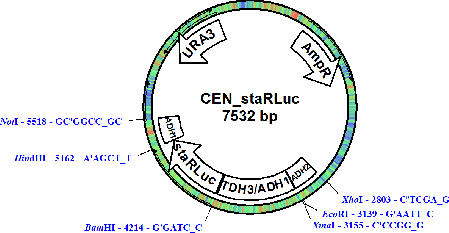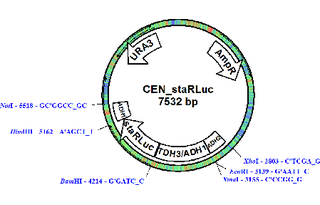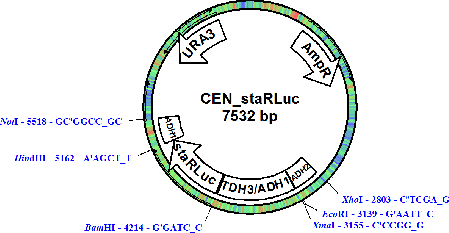pTH730-staRLuc
(Plasmid
#38226)
-
Depositing Lab
-
Sequence Information
Ordering
| Item | Catalog # | Description | Quantity | Price (USD) | |
|---|---|---|---|---|---|
| Plasmid | 38226 | Standard format: Plasmid sent in bacteria as agar stab | 1 | $89 | |
Backbone
-
Vector backbonepCENBEVY-U
- Backbone size w/o insert (bp) 6614
- Total vector size (bp) 7532
-
Vector typeYeast Expression
-
Selectable markersURA3
Growth in Bacteria
-
Bacterial Resistance(s)Ampicillin, 100 μg/mL
-
Growth Temperature37°C
-
Growth Strain(s)DH5alpha
-
Copy numberHigh Copy
Gene/Insert
-
Gene/Insert nameRenilla Luciferase
-
Alt nameRLuc
-
SpeciesSynthetic; Renilla reniformis
-
Insert Size (bp)941
-
GenBank IDAF043450.1
- Promoter TDH3 (=GPD)
Cloning Information
- Cloning method Restriction Enzyme
- 5′ cloning site BamHI (not destroyed)
- 3′ cloning site HindIII (not destroyed)
- 5′ sequencing primer M13r
- 3′ sequencing primer M13f (Common Sequencing Primers)
Resource Information
-
A portion of this plasmid was derived from a plasmid made byThe RLuc gene originated from a plasmid kindly provided by Dr David Bedwell (University of Alabama, Birmingham). Salas-Marco J, Bedwell DM (2004) Molecular and Cellular Biology 24:7769-7778.
Terms and Licenses
-
Academic/Nonprofit Terms
-
Industry Terms
- Not Available to Industry
Trademarks:
- Zeocin® is an InvivoGen trademark.
These plasmids were created by your colleagues. Please acknowledge the Principal Investigator, cite the article in which the plasmids were described, and include Addgene in the Materials and Methods of your future publications.
-
For your Materials & Methods section:
pTH730-staRLuc was a gift from Tobias von der Haar (Addgene plasmid # 38226 ; http://n2t.net/addgene:38226 ; RRID:Addgene_38226) -
For your References section:
Translation elongation can control translation initiation on eukaryotic mRNAs. Chu D, Kazana E, Bellanger N, Singh T, Tuite MF, von der Haar T. EMBO J. 2014 Jan 1;33(1):21-34. doi: 10.1002/embj.201385651. Epub 2013 Dec 19. 10.1002/embj.201385651 PubMed 24357599







